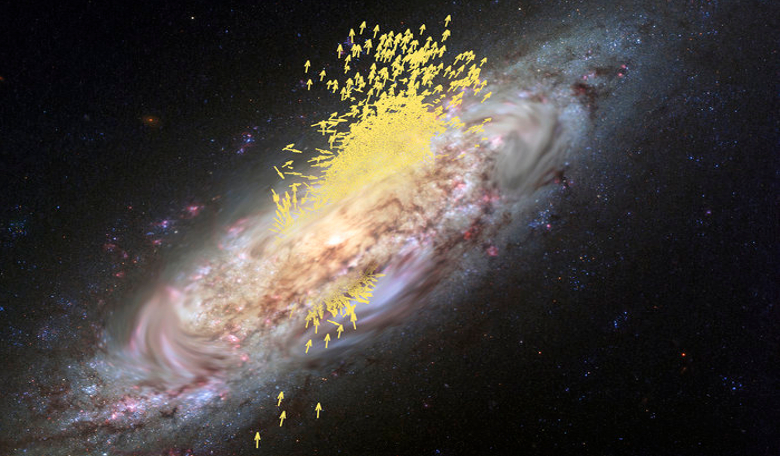Using information from the second data release of the Gaia mission, scientists have been able to rewind the history of the Milky Way and discover a major milestone in its formation; that a galaxy slightly more massive than the Small Magellanic Cloud, smashed into our galaxy about 10 billion years ago leaving its stars to populate the Milky Way’s inner halo.
The now consumed galaxy has been given the name Gaia–Enceladus after one of the Giants in ancient Greek mythology, who was the offspring of Gaia, the Earth, and Uranus, the Sky.
Its impact into the Milky Way was picked out by a team of astronomers led by Amina Helmi, University of Groningen, The Netherlands, who, after looking at the motions of seven million stars in the Gaia data, found that 30, 000 of them were behaving rather oddly.
Instead of meandering around the galaxy the same way as the hundred billion or so other stars in the Milky Way, these stars, although completely interspersed in the inner halo, all moved along elongated trajectories in the opposite direction.
However another thing also set these stars apart; aside from moving differently, they are also chemically different. Additional information supplied by the ground-based APOGEE survey found that this set of stars have chemical abundance patterns that don’t quite match the rest of the stars in the Milky Way; a trait that is expected from stars that have gatecrashed another galaxy, but hung around afterwards to form an even larger galaxy.
“The collection of stars we found with Gaia has all the properties of what you would expect from the debris of a galactic merger,” says Amina, lead author of the paper published recently in Nature.
Although Gaia–Enceladus is expected to have been about ten times smaller than the current Milky Way, it was still large; large enough to have collections of stars called globular clusters trailing after it. And, because 10 billions years ago our galaxy was also smaller, much, much smaller, it probably got the raw deal in the exchange and was effectively taken over by the new kid in town.
Nonetheless, it is not the first time that a merger has been proposed to help explain anomalies in the structure of our Milky Way. For example, If you look at a side-on image of the Milky Way, it looks like a bar with a big lump in the middle. The big lump is called the galactic bulge, whereas the bar is called the galactic disk.
The disk is in fact made up of two parts; a thin part, which is a few hundred light years deep and is the site of gas, dust and on-going star formation, while the other imaginatively titled part is called the thick disk. The thick disk is a few thousand light years deep and it is composed almost exclusively of older stars that are typically lower in metal content than those in the thin disk (in astronomy, metals refer to all elements except hydrogen and helium).
The team’s new analysis and simulations therefore help ascertain that as well as supplying the halo stars, the collision between Gaia–Enceladus and the Milky Way when it was much smaller, could also have disturbed the pre-existing stars to help form the thick disc.
“Seeing that we are now starting to unravel the formation history of the Milky Way is very exciting,” says Anthony Brown, Leiden University, The Netherlands, who is a co-author of the paper and also chair of the Gaia Data Processing and Analysis Consortium Executive. This is what Gaia was built for added Amina.











